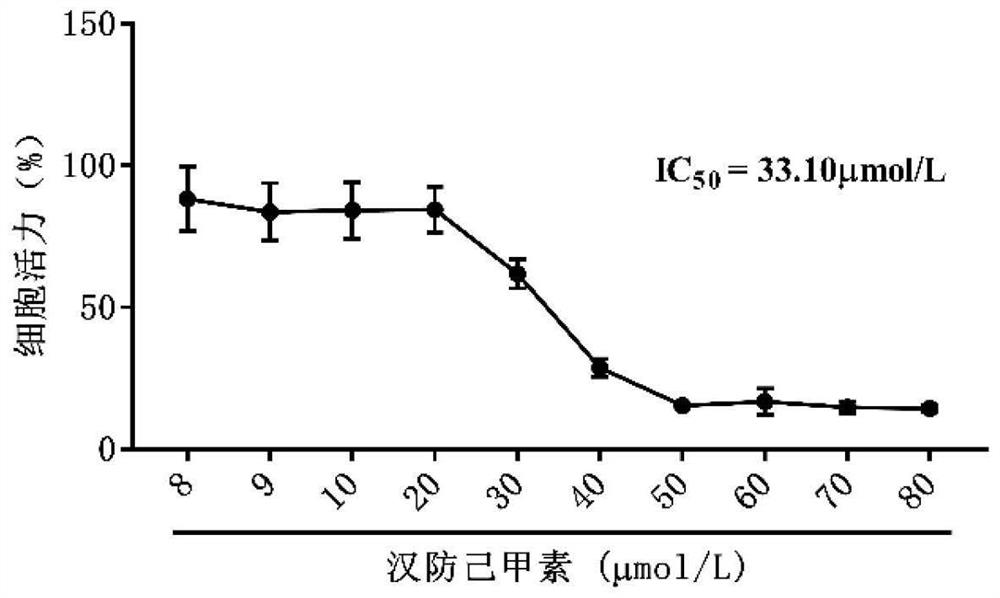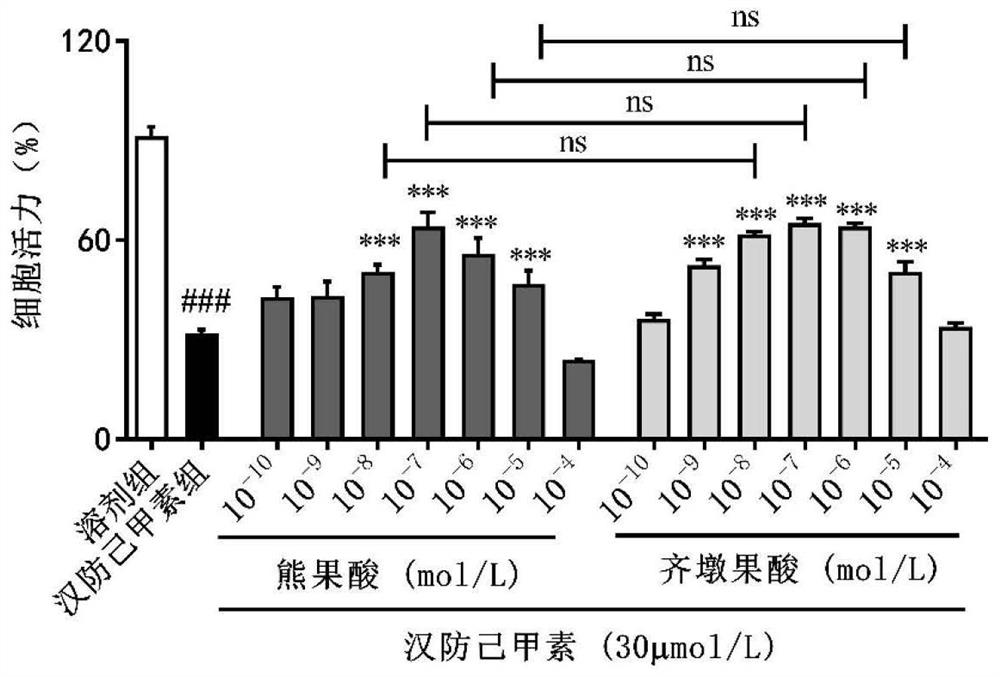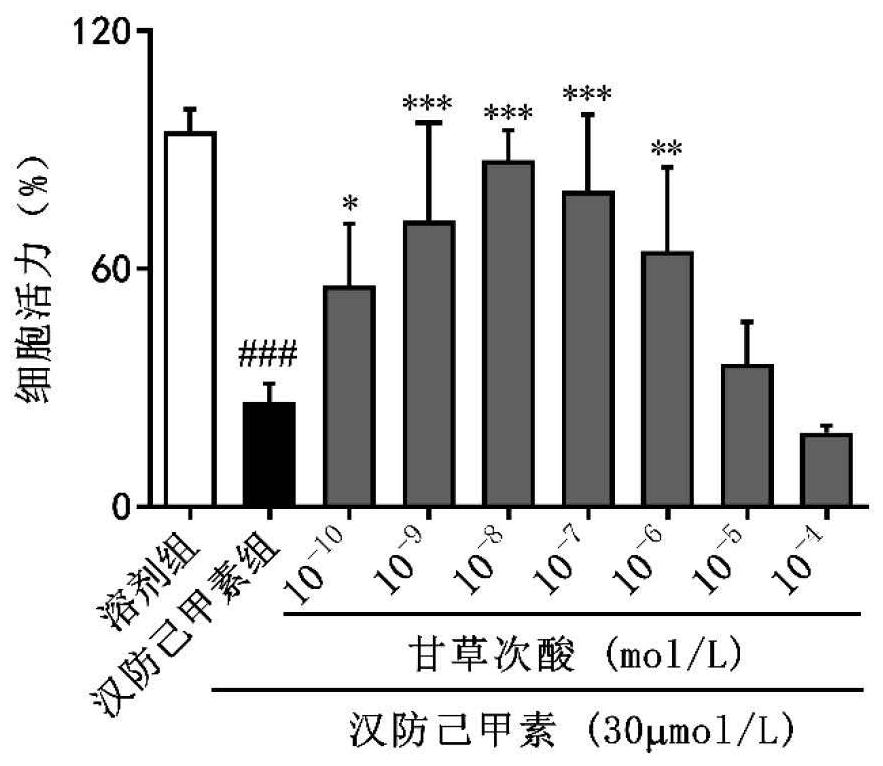Pharmaceutical composition for synergistically inhibiting drug-induced liver injury induced by tetrandrine
A drug-induced liver injury, Tetrandrine technology, applied in the field of medicine, to achieve the effect of inhibiting liver injury, inhibiting apoptosis, and good application prospects
- Summary
- Abstract
- Description
- Claims
- Application Information
AI Technical Summary
Problems solved by technology
Method used
Image
Examples
Embodiment 1
[0037] The cells used in the present invention are HepG2 cells. In order to detect the effect of tetrandrine on the cell apoptosis, HepG2 cells were seeded in 96-well cell culture plates and divided into blank control group and tetrandrine administration group (8, 9, 10, 20, 30, 40, 50, 60, 70, 80 μM). When the cells grew to 80%-90%, different concentrations of tetrandrine were administered. After 24 hours of culture, the cell viability was detected using the CCK-8 cell viability detection kit, and the half inhibitory concentration IC was calculated using GraphPad Prism 5.0. 50 , the result is as figure 1 shown. Depend on figure 1 It can be seen that tetrandrine can inhibit the cell viability of HepG2 cells, and its IC 50 The value is 33.10 μM. Therefore, 30 μM tetrandrine was selected as the dosage for the subsequent cell injury model.
Embodiment 2
[0039] Study on the protective effect of ursolic acid and oleanolic acid on HepG2 cell injury induced by tetrandrine: HepG2 cells were seeded in 96-well plates and cultured overnight. The experiment was divided into blank group and tetrandrine group (30μM ) modeling group, different concentrations of ursolic acid (10 -10 、10 -9 、10 -8 、10 -7 、10 -6 、10 -5 、10 -4 mol / L) administration group, different concentrations of oleanolic acid (10 -10 、10 -9 、10 -8 、10 -7 、10 -6 、10 -5 、10 -4 mol / L) administration group, after 24 hours of administration and treatment, the cell viability was detected by CCK-8 kit, and the inhibitory effect of ursolic acid and oleanolic acid on tetrandrine-induced apoptosis was investigated. The result is as figure 2 As shown, compared with the blank group, tetrandrine can reduce the cell viability of HepG2 cells, at 10 -8 to 10 -5 In the range of mol / L, ursolic acid can significantly inhibit the apoptosis induced by tetrandrine, and the op...
Embodiment 3
[0041] Protective effect of glycyrrhetinic acid on Tetrandrine-induced HepG2 cell damage: HepG2 cells were seeded in 96-well plates and cultured overnight. The experiment was divided into blank group, Tetrandrine (30 μM) Ursolic acid (10 -10 、10 -9 、10 -8 、10 -7 、10 -6 、10 -5 、10 -4 mol / L) administration group, after administration and treatment for 24 hours, the cell viability was detected by CCK-8 kit, and the inhibitory effect of glycyrrhetinic acid on tetrandrine-induced apoptosis was investigated. The result is as image 3 As shown, compared with the blank group, tetrandrine can reduce the cell viability of HepG2 cells, at 10 -10 to 10 -6 Within the concentration range of mol / L, glycyrrhetinic acid can significantly inhibit the apoptosis induced by tetrandrine, and the optimal concentration is 10 -8 mol / L, the optimal concentration range is 10 -10 -10 -8 mol / L, indicating that low concentrations of glycyrrhetinic acid have a better inhibitory effect on tetrandr...
PUM
 Login to View More
Login to View More Abstract
Description
Claims
Application Information
 Login to View More
Login to View More - R&D
- Intellectual Property
- Life Sciences
- Materials
- Tech Scout
- Unparalleled Data Quality
- Higher Quality Content
- 60% Fewer Hallucinations
Browse by: Latest US Patents, China's latest patents, Technical Efficacy Thesaurus, Application Domain, Technology Topic, Popular Technical Reports.
© 2025 PatSnap. All rights reserved.Legal|Privacy policy|Modern Slavery Act Transparency Statement|Sitemap|About US| Contact US: help@patsnap.com



